标签:
为了适应各种尺寸的屏幕,谷歌推出Fragment,可以把Fragment成Activity的一个组成部分,它拥有自己的生命周期、可以接收并处理用户的各种事件,还可以动态的增删改某个Fragment
可以把Fragment当成普通的控件使用,直接写在布局文件中,然后新建一个继承自Fragment的类加载这个布局,然后在Activity的布局文件中直接引用这个Fragment,就是这么简单:
MainActivity.java
package com.example.fragmentdemo; import android.app.Activity; import android.os.Bundle; import android.view.Window; public class MainActivity extends Activity { @Override public void onCreate(Bundle savedInstanceState) { super.onCreate(savedInstanceState); requestWindowFeature(Window.FEATURE_NO_TITLE); setContentView(R.layout.activity_main); } }
activity_main.xml
<LinearLayout xmlns:android="http://schemas.android.com/apk/res/android" xmlns:tools="http://schemas.android.com/tools" android:layout_width="match_parent" android:layout_height="match_parent" android:orientation="horizontal" tools:context="com.example.fragmentdemo.MainActivity" > <fragment android:id="@+id/fragment1" android:name="com.example.fragmentdemo.fragment.Fragment1" android:layout_width="wrap_content" android:layout_height="match_parent" android:layout_weight="1" /> <fragment android:id="@+id/fragment2" android:name="com.example.fragmentdemo.fragment.Fragment2" android:layout_width="wrap_content" android:layout_height="match_parent" android:layout_weight="1" /> </LinearLayout>
Fragment1.java
package com.example.fragmentdemo.fragment; import com.example.fragmentdemo.R; import android.app.Fragment; import android.os.Bundle; import android.view.LayoutInflater; import android.view.View; import android.view.ViewGroup; public class Fragment1 extends Fragment { @Override public View onCreateView(LayoutInflater inflater, ViewGroup container, Bundle savedInstanceState) { View view = inflater.inflate(R.layout.fragment1, container, false); return view; } }
fragment1.xml
<?xml version="1.0" encoding="utf-8"?> <LinearLayout xmlns:android="http://schemas.android.com/apk/res/android" android:layout_width="match_parent" android:layout_height="match_parent" android:orientation="vertical" > <TextView android:id="@+id/text1" android:layout_width="match_parent" android:layout_height="match_parent" android:background="#DDA0DD" android:text="这是Fragment1" /> </LinearLayout>
Fragment2.java
package com.example.fragmentdemo.fragment; import com.example.fragmentdemo.R; import android.app.Fragment; import android.os.Bundle; import android.view.LayoutInflater; import android.view.View; import android.view.ViewGroup; public class Fragment2 extends Fragment { @Override public View onCreateView(LayoutInflater inflater, ViewGroup container, Bundle savedInstanceState) { // TODO Auto-generated method stub return inflater.inflate(R.layout.fragment2, container, false); } }
fragment2.xml
<?xml version="1.0" encoding="utf-8"?> <LinearLayout xmlns:android="http://schemas.android.com/apk/res/android" android:layout_width="match_parent" android:layout_height="match_parent" android:background="#7B68EE" android:orientation="vertical" > <Button android:layout_width="match_parent" android:layout_height="wrap_content" android:text="这是Fragment2" /> </LinearLayout>
运行结果:
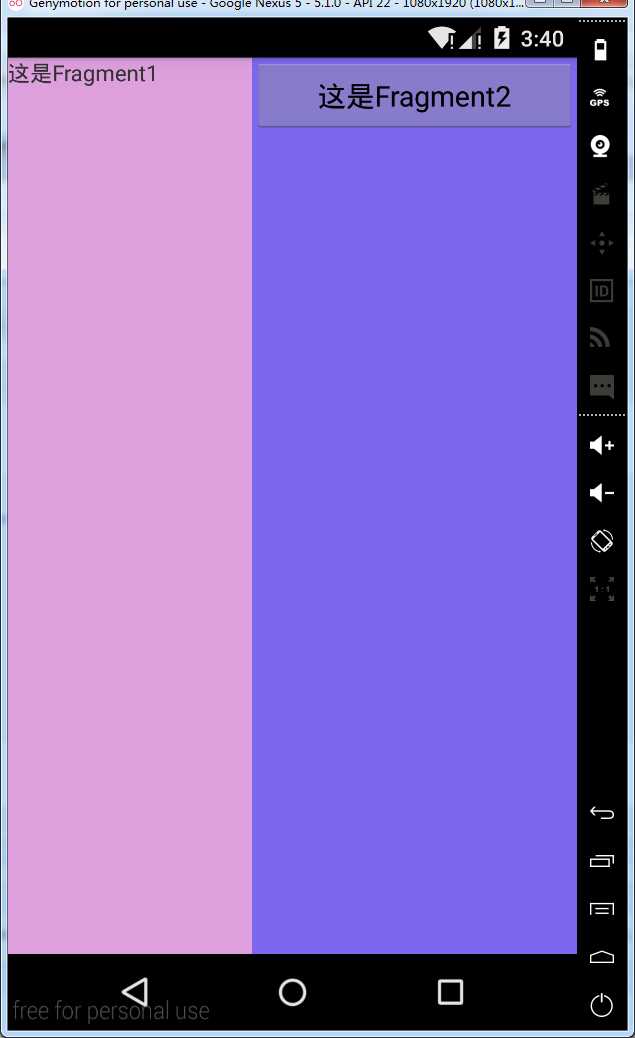
动态使用Fragment
动态使用Fragment需要以下几个步骤:
1.获取到FragmentManager,在Activity中可以直接通过getFragmentManager得到。
2.开启一个事务,通过调用beginTransaction方法开启。
3.使用add(),replace(),remove(),hide(),show(),detach(),attach()等方法编辑Fragment
add()——往Activity中添加一个Fragment
replace()——使用另外一个Fragment替换当前的Fragment
remove()——移除一个Fragment
hide()——隐藏一个Fragment
show()——将隐藏的Fragment显示
detach()——会将view从UI中移除,和remove()不同,此时fragment的状态依然由FragmentManager维护。
attach()——重建View视图,附加到UI上并显示
4.提交事务,调用commit方法提交。
实现微信地步菜单:
MainActivity.java
package cn.lixyz.test; import android.app.Activity; import android.os.Bundle; import android.view.Window; import android.widget.RadioGroup; import android.widget.RadioGroup.OnCheckedChangeListener; import cn.lixyz.test.fragment.DiscoverFragment; import cn.lixyz.test.fragment.MeFragment; import cn.lixyz.test.fragment.TXLFragment; import cn.lixyz.test.fragment.WeChatFragment; public class MainActivity extends Activity implements OnCheckedChangeListener { private RadioGroup rg_tab_buttons; @Override protected void onCreate(Bundle savedInstanceState) { super.onCreate(savedInstanceState); requestWindowFeature(Window.FEATURE_NO_TITLE); setContentView(R.layout.activity_main); getFragmentManager().beginTransaction().add(R.id.layout, new WeChatFragment(), "wechat").commit(); rg_tab_buttons = (RadioGroup) findViewById(R.id.rg_tab_buttons); rg_tab_buttons.setOnCheckedChangeListener(this); } @Override public void onCheckedChanged(RadioGroup group, int checkedId) { switch (checkedId) { case R.id.rb_wechat: getFragmentManager().beginTransaction().replace(R.id.layout, new WeChatFragment(), "wechat").commit(); break; case R.id.rb_txl: getFragmentManager().beginTransaction().replace(R.id.layout, new TXLFragment(), "txl").commit(); break; case R.id.rb_discover: getFragmentManager().beginTransaction().replace(R.id.layout, new DiscoverFragment(), "discover").commit(); break; case R.id.rb_me: getFragmentManager().beginTransaction().replace(R.id.layout, new MeFragment(), "me").commit(); break; } } }
activity_main.xml
<?xml version="1.0" encoding="utf-8"?> <LinearLayout xmlns:android="http://schemas.android.com/apk/res/android" android:layout_width="match_parent" android:layout_height="match_parent" android:background="#f9f9f9" android:orientation="vertical" > <LinearLayout android:id="@+id/layout" android:layout_width="wrap_content" android:layout_height="wrap_content" android:layout_weight="1" android:orientation="vertical" > </LinearLayout> <RadioGroup android:id="@+id/rg_tab_buttons" android:layout_width="match_parent" android:layout_height="wrap_content" android:orientation="horizontal" > <TextView android:layout_width="wrap_content" android:layout_height="wrap_content" android:layout_weight="1" /> <RadioButton android:id="@+id/rb_wechat" android:layout_width="wrap_content" android:layout_height="wrap_content" android:background="@drawable/wechat_icon" android:button="@null" /> <TextView android:layout_width="wrap_content" android:layout_height="wrap_content" android:layout_weight="1" /> <RadioButton android:id="@+id/rb_txl" android:layout_width="wrap_content" android:layout_height="wrap_content" android:background="@drawable/txl_icon" android:button="@null" /> <TextView android:layout_width="wrap_content" android:layout_height="wrap_content" android:layout_weight="1" /> <RadioButton android:id="@+id/rb_discover" android:layout_width="wrap_content" android:layout_height="wrap_content" android:background="@drawable/discover_icon" android:button="@null" /> <TextView android:layout_width="wrap_content" android:layout_height="wrap_content" android:layout_weight="1" /> <RadioButton android:id="@+id/rb_me" android:layout_width="wrap_content" android:layout_height="wrap_content" android:background="@drawable/me_icon" android:button="@null" /> <TextView android:layout_width="wrap_content" android:layout_height="wrap_content" android:layout_weight="1" /> </RadioGroup> </LinearLayout>
DiscoverFragment.java
package cn.lixyz.test.fragment; import android.app.Fragment; import android.os.Bundle; import android.view.LayoutInflater; import android.view.View; import android.view.ViewGroup; import cn.lixyz.test.R; public class DiscoverFragment extends Fragment { @Override public View onCreateView(LayoutInflater inflater, ViewGroup container, Bundle savedInstanceState) { return inflater.inflate(R.layout.discover_fragment, container, false); } }
discover_fragment.xml
<?xml version="1.0" encoding="utf-8"?> <LinearLayout xmlns:android="http://schemas.android.com/apk/res/android" android:layout_width="match_parent" android:layout_height="match_parent" android:orientation="vertical" > <TextView android:layout_width="wrap_content" android:layout_height="wrap_content" android:text="这是发现页面" /> </LinearLayout>
MeFragment.java
package cn.lixyz.test.fragment; import android.app.Fragment; import android.os.Bundle; import android.view.LayoutInflater; import android.view.View; import android.view.ViewGroup; import cn.lixyz.test.R; public class MeFragment extends Fragment { @Override public View onCreateView(LayoutInflater inflater, ViewGroup container, Bundle savedInstanceState) { return inflater.inflate(R.layout.me_fragment, container, false); } }
me_fragment.xml
<?xml version="1.0" encoding="utf-8"?> <LinearLayout xmlns:android="http://schemas.android.com/apk/res/android" android:layout_width="match_parent" android:layout_height="match_parent" android:orientation="vertical" > <TextView android:layout_width="wrap_content" android:layout_height="wrap_content" android:text="这是我页面" /> </LinearLayout>
TXLFragment.java
package cn.lixyz.test.fragment; import android.app.Fragment; import android.os.Bundle; import android.view.LayoutInflater; import android.view.View; import android.view.ViewGroup; import cn.lixyz.test.R; public class TXLFragment extends Fragment { @Override public View onCreateView(LayoutInflater inflater, ViewGroup container, Bundle savedInstanceState) { return inflater.inflate(R.layout.txl_fragment, container, false); } }
txl_fragment.xml
<?xml version="1.0" encoding="utf-8"?> <LinearLayout xmlns:android="http://schemas.android.com/apk/res/android" android:layout_width="match_parent" android:layout_height="match_parent" android:orientation="vertical" > <TextView android:layout_width="wrap_content" android:layout_height="wrap_content" android:text="这是通讯录页面" /> </LinearLayout>
WeChatFragment.java
package cn.lixyz.test.fragment; import android.app.Fragment; import android.os.Bundle; import android.view.LayoutInflater; import android.view.View; import android.view.ViewGroup; import cn.lixyz.test.R; public class WeChatFragment extends Fragment { @Override public View onCreateView(LayoutInflater inflater, ViewGroup container, Bundle savedInstanceState) { return inflater.inflate(R.layout.wechat_fragment, container, false); } }
wechat_fragment.xml
<?xml version="1.0" encoding="utf-8"?> <LinearLayout xmlns:android="http://schemas.android.com/apk/res/android" android:layout_width="match_parent" android:layout_height="match_parent" android:orientation="vertical" > <TextView android:layout_width="wrap_content" android:layout_height="wrap_content" android:text="这是微信页面" /> </LinearLayout>
运行结果:
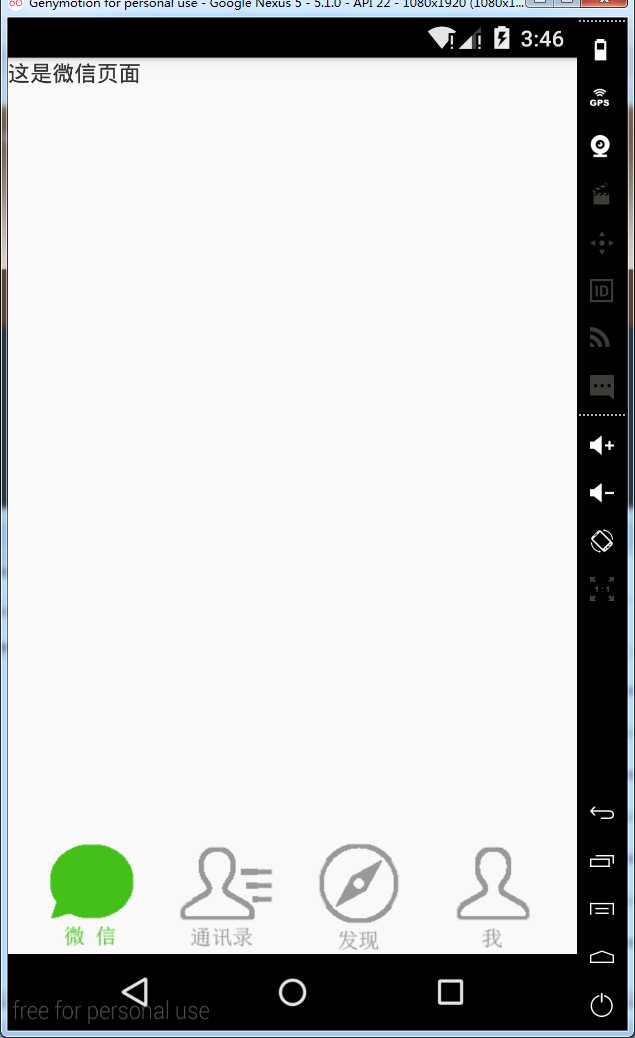
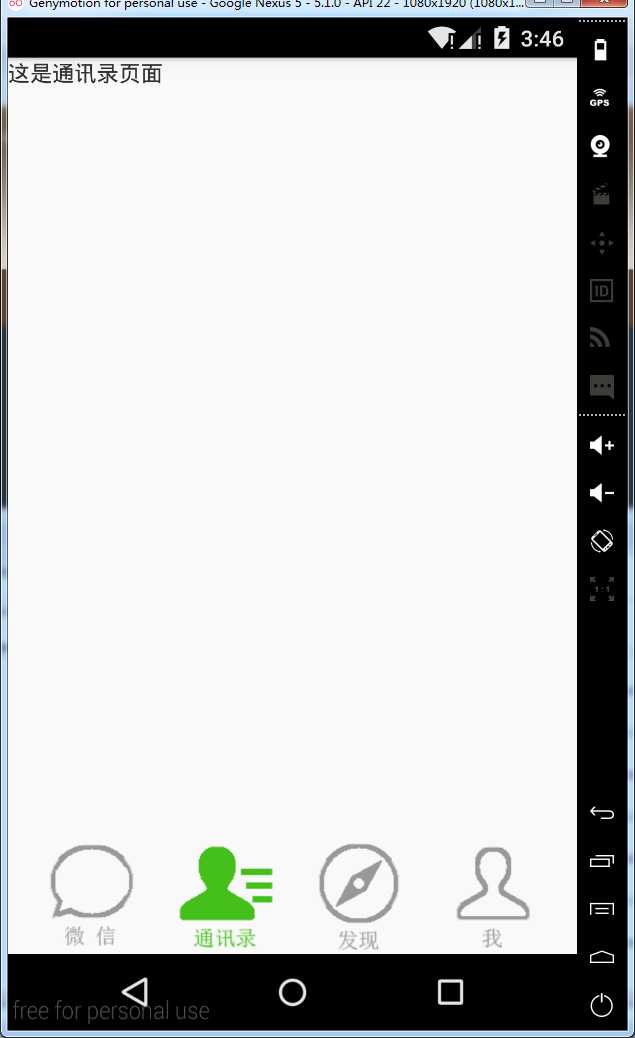
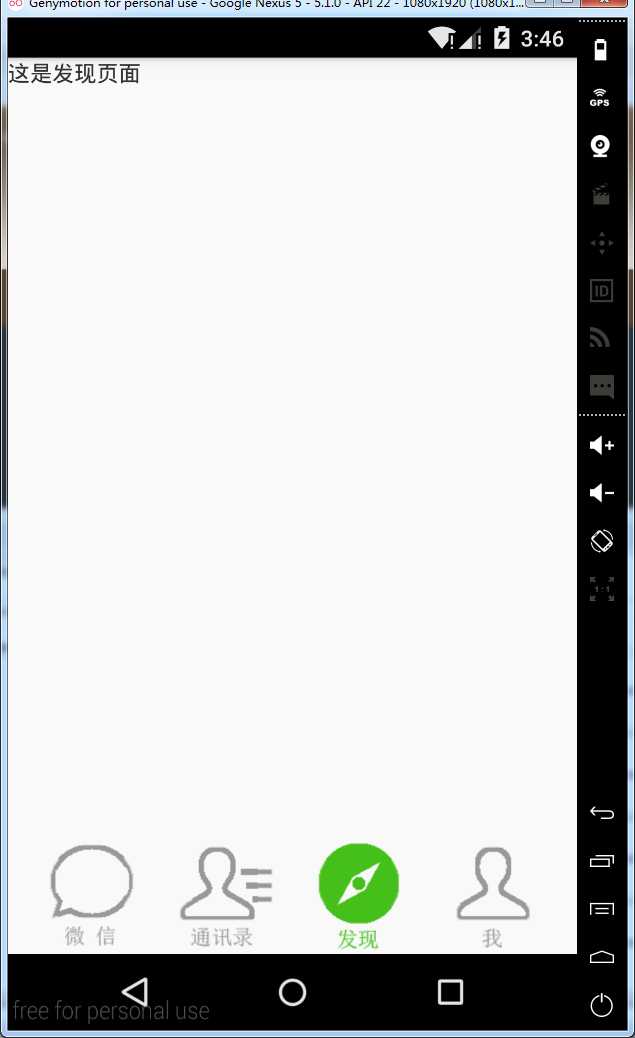
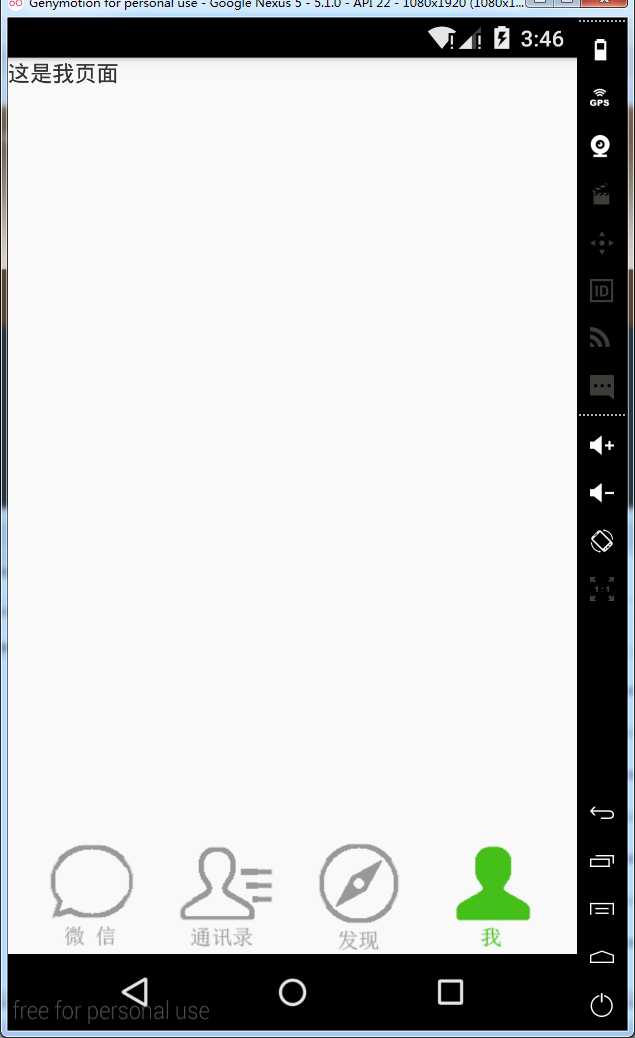
和Activity一样,Fragment同样也拥有自己的生命周期
package com.example.fragmentdemo.fragment; import com.example.fragmentdemo.R; import android.app.Activity; import android.app.Fragment; import android.os.Bundle; import android.util.Log; import android.view.LayoutInflater; import android.view.View; import android.view.ViewGroup; public class Fragment1 extends Fragment { @Override public View onCreateView(LayoutInflater inflater, ViewGroup container, Bundle savedInstanceState) { Log.d("TTTT", "onCreateView方法运行了..."); return inflater.inflate(R.layout.fragment1, container, false); } @Override public void onAttach(Activity activity) { super.onAttach(activity); Log.d("TTTT", "onAttach方法运行了..."); } @Override public void onCreate(Bundle savedInstanceState) { super.onCreate(savedInstanceState); Log.d("TTTT", "onCreate方法运行了..."); } @Override public void onActivityCreated(Bundle savedInstanceState) { super.onActivityCreated(savedInstanceState); Log.d("TTTT", "onActivityCreated方法运行了..."); } @Override public void onStart() { super.onStart(); Log.d("TTTT", "onStart方法运行了..."); } @Override public void onResume() { super.onResume(); Log.d("TTTT", "onResume方法运行了..."); } @Override public void onPause() { super.onPause(); Log.d("TTTT", "onPause方法运行了..."); } @Override public void onStop() { super.onStop(); Log.d("TTTT", "onStop方法运行了..."); } @Override public void onDestroyView() { super.onDestroyView(); Log.d("TTTT", "onDestroyView方法运行了..."); } @Override public void onDestroy() { super.onDestroy(); Log.d("TTTT", "onDestroy方法运行了..."); } @Override public void onDetach() { super.onDetach(); Log.d("TTTT", "onDetach方法运行了..."); } }
运行程序
12-29 12:12:29.490: D/TTTT(8133): onAttach方法运行了... 12-29 12:12:29.490: D/TTTT(8133): onCreate方法运行了... 12-29 12:12:29.490: D/TTTT(8133): onCreateView方法运行了... 12-29 12:12:29.490: D/TTTT(8133): onActivityCreated方法运行了... 12-29 12:12:29.491: D/TTTT(8133): onStart方法运行了... 12-29 12:12:29.491: D/TTTT(8133): onResume方法运行了...
按HOME键回到桌面
12-29 12:13:17.164: D/TTTT(8133): onPause方法运行了...
12-29 12:13:17.793: D/TTTT(8133): onStop方法运行了...
再次进入程序
12-29 12:13:38.604: D/TTTT(8133): onStart方法运行了...
12-29 12:13:38.604: D/TTTT(8133): onResume方法运行了...
退出程序
12-29 12:13:55.785: D/TTTT(8133): onPause方法运行了... 12-29 12:13:56.464: D/TTTT(8133): onStop方法运行了... 12-29 12:13:56.464: D/TTTT(8133): onDestroyView方法运行了... 12-29 12:13:56.464: D/TTTT(8133): onDestroy方法运行了... 12-29 12:13:56.464: D/TTTT(8133): onDetach方法运行了...
看到这里,我相信大多数朋友已经非常明白了,因为这和Activity的生命周期太相似了。只是有几个Activity中没有的新方法,这里需要重点介绍一下:
onAttach方法:Fragment和Activity建立关联的时候调用。
onCreateView方法:为Fragment加载布局时调用。
onActivityCreated方法:当Activity中的onCreate方法执行完后调用。
onDestroyView方法:Fragment中的布局被移除时调用。
onDetach方法:Fragment和Activity解除关联的时候调用。
标签:
原文地址:http://www.cnblogs.com/xs104/p/5079351.html